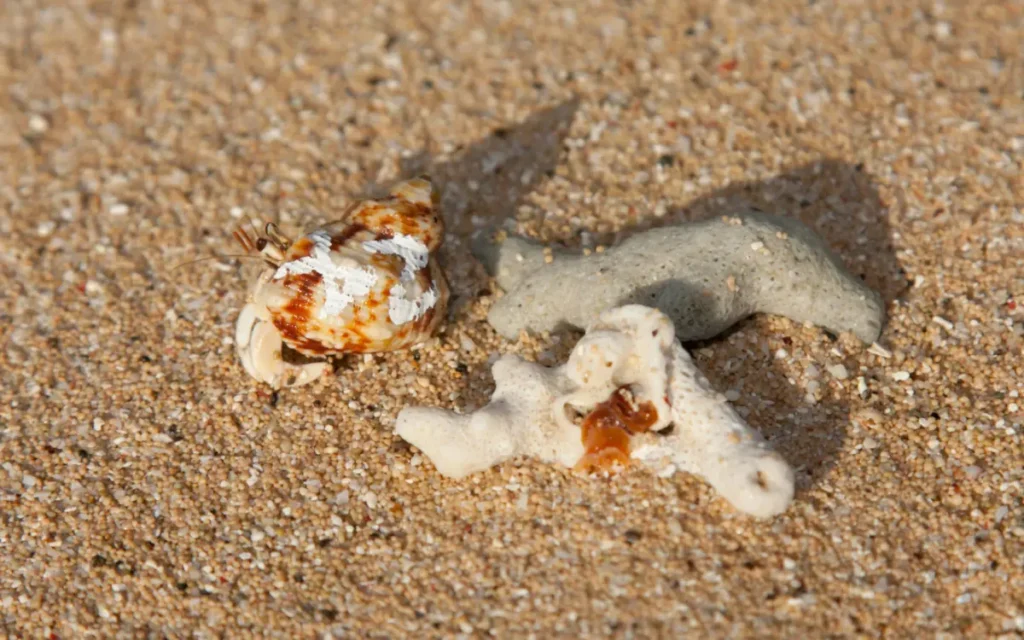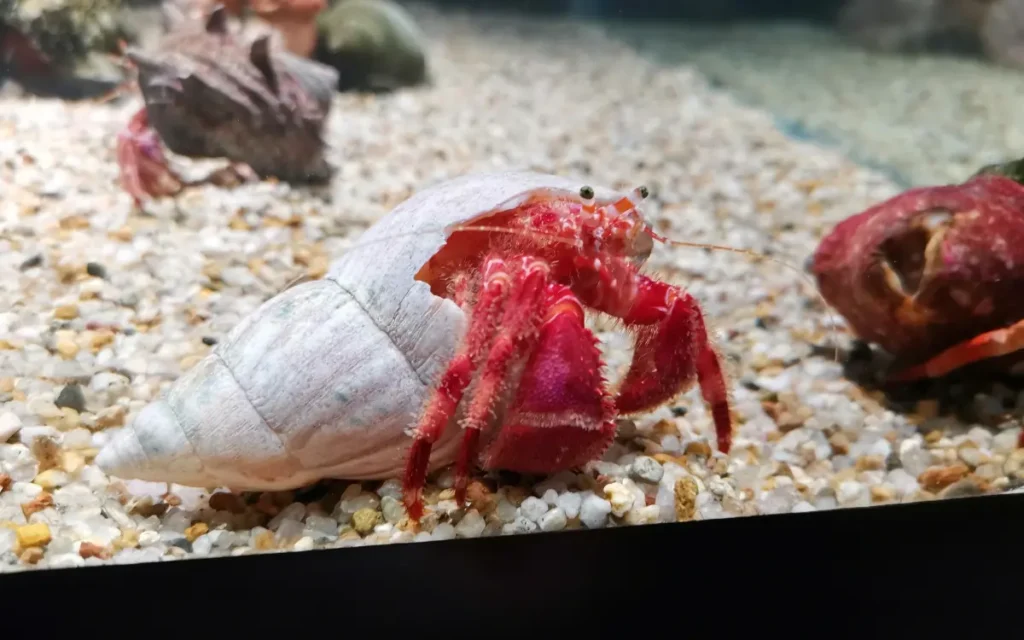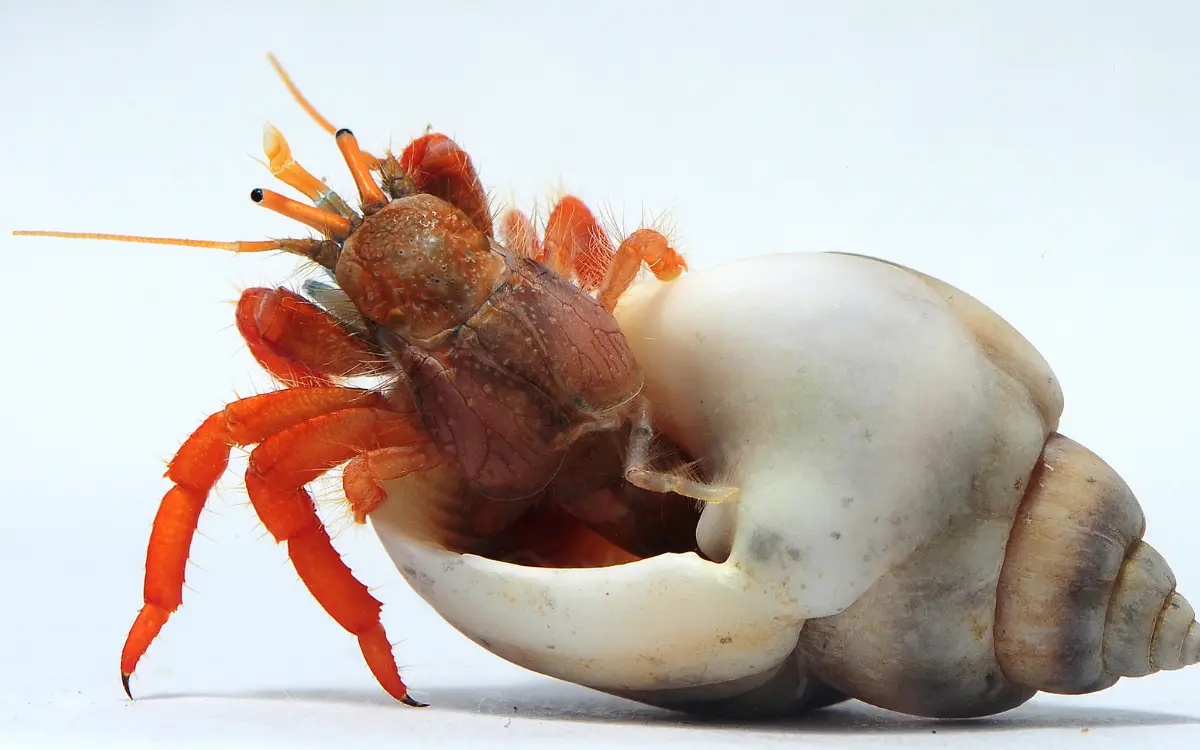Hermit crabs are fascinating pets that carry their homes on their backs. One essential aspect of their care is understanding molting, when they shed their old exoskeleton.
Recognizing molting signs helps keep them healthy. This guide covers the signs, stages, and care during molting.
Signs Your Hermit Crab is About to Molt

1.Behavioral Changes:
Increased Digging: One of the first signs is increased digging. Hermit crabs dig to create a safe, moist place to molt.
Decreased Activity: You might notice less movement and more time spent hiding as they prepare for the energy-intensive process of molting.
Physical Changes:
Dull Exoskeleton: The shell may look dull and faded, indicating the old exoskeleton is ready to be shed.
Cloudy Eyes: The eyes might appear cloudy or milky, another sign that molting is approaching.
Eating and Drinking Habits:
Increased Eating: In the days or weeks leading up to a molt, hermit crabs often eat more to store energy for the process.
Increased Drinking: Increased water intake helps them stay hydrated and supports the molting process.
Shell Selection Behavior:
Exploring Shells: They might start examining and trying on different shells to ensure they have a suitable new home once the molt is complete.
2.Stages of Hermit Crab Molting
Pre-molt Stage:
Behavioral and Physical Signs: Increased digging, decreased activity, dull exoskeleton, and cloudy eyes.
Preparation: Eating and drinking more to store energy and stay hydrated.
Duration: This stage can last from a few days to several weeks, depending on the crab’s size and age.
Molting Stage:
Shedding the Exoskeleton: The crab will shed its old exoskeleton, starting from the legs and working its way to the body.
Timeframe: The actual molting process can take several hours to a few days. During this time, the crab is extremely vulnerable and should not be disturbed.
Post-molt Stage:
Recovery and Hardening: After molting, the crab will look soft and pale. It takes time for the new exoskeleton to harden.
Eating the Old Exoskeleton: They often eat the old exoskeleton to recycle calcium and other nutrients.
Gradual Activity Increase: This stage can last from a few days to a few weeks. During this time, the crab will gradually become more active as its new exoskeleton hardens and strengthens.
What Hermit Crabs Look Like During Molting

Old Exoskeleton:
Appearance: The shed exoskeleton looks like a complete replica of the crab, including legs and claws. It is often left in the molting burrow or nearby.
Characteristics: The old exoskeleton appears brittle and dull compared to the crab’s new body.
Newly Molted Crab:
Soft and Fragile: After shedding, the crab’s new body is very soft and vulnerable.
Pale Color: The newly molted crab looks pale, almost translucent, as the new exoskeleton has not yet hardened.
Lethargic: They tend to be very still and inactive as they recover and their new exoskeleton hardens.
Is Molting Painful for Hermit Crabs?
Understanding the Molting Process:
Natural and Essential: Molting is a natural and essential process for growth and health. It involves shedding the old exoskeleton and forming a new one.
Energy-Intensive: The process requires significant energy and can be stressful for the crab.
Potential Discomfort and Stress:
Discomfort: While it’s hard to say if hermit crabs feel pain the way humans do, the process can be uncomfortable. The crab’s body undergoes significant changes, and the new exoskeleton is initially very soft and vulnerable.
Stress: Molting can be a stressful time. Ensuring a safe, quiet, and undisturbed environment can help reduce this stress.
Care and Observation: Providing proper care, including a moist and secure environment, can minimize discomfort and support the crab through this challenging period.
What Happens If You Touch or Disturb a Molting Hermit Crab?
Potential Risks and Consequences:
Physical Harm: Molting crabs are extremely fragile. Touching or disturbing them can cause physical damage to their soft, new exoskeleton.
Increased Stress: Disturbing a molting crab can cause significant stress, negatively impacting their molting process and overall health.
Interrupted Molting: If a crab is disturbed during molting, it may not complete the process properly, leading to complications or even death.
Best Practices for Handling Molting Hermit Crabs:
Do Not Disturb: Avoid handling or moving a molting crab. Leave them undisturbed in their burrow or hiding spot.
Provide a Safe Environment: Ensure the habitat is quiet, safe, and free from potential disturbances from other crabs or pets.
Maintain Proper Humidity and Temperature: Keep the environment stable with appropriate humidity and temperature levels to support the molting process.
Observe from a Distance: Check on your crab from a distance to ensure they are safe, but avoid direct interaction.
Isolation if Necessary: If you have multiple crabs, consider isolating the molting crab to prevent disturbances from others.
Read also:- fun facts about hermit crabs
Frequency of Molting in Hermit Crabs
Factors Affecting Molting Frequency:
- Age: Younger crabs molt more frequently than older ones.
- Size: Smaller crabs molt more often than larger crabs.
- Health and Nutrition: Well-nourished crabs with proper care molt regularly.
- Environmental Conditions: Optimal humidity and temperature support regular molting cycles.
- Stress Levels: High stress can delay molting, while a calm environment promotes regular molting.

Typical Molting Intervals Based on Age and Size:
| Age/Size of Hermit Crab | Typical Molting Interval |
|---|---|
| Young (under 1 year) | Every 1-2 months |
| Juvenile (1-2 years) | Every 2-4 months |
| Adult (2-5 years) | Every 4-6 months |
| Large Adult (5+ years) | Every 6-12 months |
| Small Crabs (under 1 inch) | Every 1-2 months |
| Medium Crabs (1-2 inches) | Every 2-4 months |
| Large Crabs (2-3 inches) | Every 4-6 months |
| Extra Large Crabs (over 3 inches) | Every 6-12 months |
Identifying a Dead Hermit Crab
Signs to Differentiate Between Molting and Death:
Smell: A dead hermit crab will emit a strong, foul odor, similar to the smell of rotting fish. Molting crabs do not have this smell.
Movement: Molting crabs will occasionally twitch or move slightly, even if they appear inactive. Dead crabs show no movement at all.
Exoskeleton Appearance: During molting, a crab will shed its exoskeleton, which can look like a dead crab. However, the actual crab should be nearby, either buried or in a new, softer form. A dead crab’s exoskeleton remains intact and does not appear shed.
Position and Location: Molting crabs usually burrow and hide. If you find a crab out in the open and unresponsive for an extended period, it might be dead.
What to Do If You Suspect Your Hermit Crab is Dead:
Check for Movement: Gently observe for any slight movement or twitching. Avoid touching the crab directly.
Smell Test: Carefully smell the crab. A strong, foul odor is a clear indicator of death.
Examine the Habitat: Look for signs of a recently shed exoskeleton nearby. If you find an empty shell and a soft crab, it’s likely a molting crab.
Isolation: If you suspect death but are unsure, isolate the crab in a separate container with substrate and a shell. Observe for any signs of life over the next 24-48 hours.
Final Check: If there is no movement and the smell persists, it is likely the crab has died. You can then proceed to remove it from the habitat to prevent any potential health issues for other crabs.

